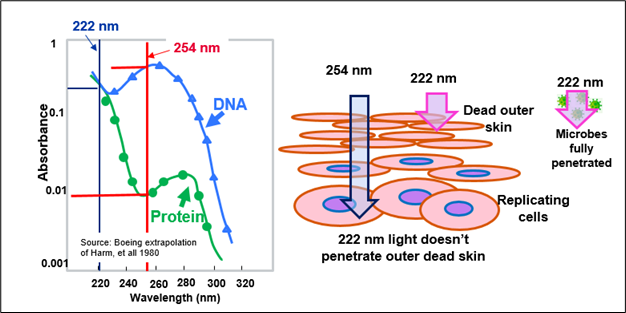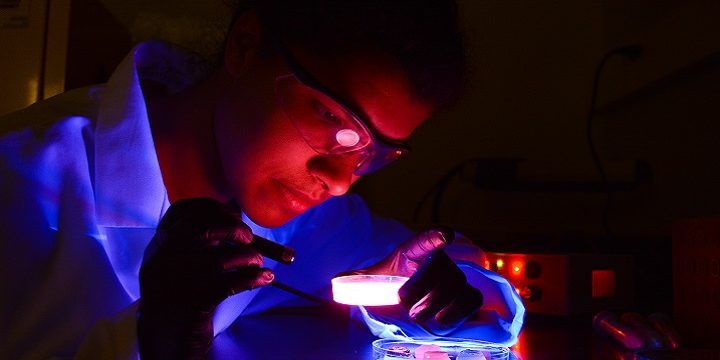Abstract
Both 254-nm UV light and 222-nm UV are germicidal light wavelengths that inactivate bacteria and viruses. Like standard 254-nm UVC, 222-nm UV light breaks the DNA bonds inside a microbe’s nucleus, which can prevent microbes from replicating. In addition, 222-nm UV is highly absorbed by protein bonds in the membrane shells of microbes and human cells. This protein interaction makes 222-nm light effective at defeating microbes and much safer than 254-nm UV for human exposure. Current data indicates that 222-nm light is more than 100x safer for humans than 254-nm light. This can allow 222-nm UV to be safely used when humans are present.
The COVID-19 pandemic has increased the need for disinfected public spaces, including buildings, ships, aircraft, and other transport vehicles of all types. It is imperative to reduce pathogen transmission risk in both civilian and military operations. Thorough and efficient disinfection procedures must be implemented to return to pre-pandemic military and civilian operations cost-effectively. One valuable COVID disinfection option is UV light.
Not all UV light is the same. Some UV wavelengths are better than others at disinfection, and some are safer for humans. Invisible to the human eye, UV is light at wavelengths shorter than 400 nm and greater than 100 nm. The UV spectrum is broken into sub-bands of UVA, UVB, and UVC (Figure 1). The UVA waveband is nearly visible and commonly called black light. UVB, a slightly shorter wavelength, is a major factor in getting sunburned and can cause skin cancer. Both UVA and UVB easily enter the earth’s atmosphere and are present in sunlight. On the other hand, the UVC wavelengths, which are shorter than UVB, are blocked by the ozone in the earth’s upper atmosphere and not typically present in sunlight at the earth’s surface. This is important for germicidal effectiveness because it means microbes have fewer defenses against the shorter UVC wavelengths. Even within this UVC band, not all light is the same. According to studies at Columbia and other universities [1–8], UV light at the 222-nm wavelength has similar germicidal capabilities of the more widely used 254-nm UV light to kill or inactivate microbes (bacteria and viruses), but it does not produce the same damaging effects on skin or eyes as 254-nm light. This improved safety is because the shorter 222-nm UV wavelength has reduced penetration depth in human tissue. While the negative effects on humans are reduced, 222-nm light has increased performance for killing some bacteria and viruses.

Figure 1: UV Spectrum (Source: Boeing).
Currently, the easiest way to make 222-nm light is to use an excimer lamp, which is a glass tube filled with gas and fitted with high-voltage electrodes along its length. Excimer lamps are basically lightning in a bottle (Figure 2). A high-voltage discharge between inner and outer electrodes creates a “temporary” gas molecule that rapidly decays. Different gas mixtures create different light frequencies. An excimer lamp filled with a mixture of krypton (Kr) and chlorine (Cl) gas primarily makes 222-nm light when energized. The output intensity of the 222 nm lamp can be varied by changing the input power, allowing the lamp to be instantly brightened or dimmed as required. Depending on design, excimer lamps can be run at power levels from as low as a few watts to kilowatts. To improve the human safety of the Kr/Cl 222-nm light even further, an optical filter is added to remove small amounts of harmful wavelengths that might also have been generated above 230 nm.

Figure 2: A 222 nm Excimer Lamp – Lightning in a Bottle (Source: Boeing).
Light from UVC systems is absorbed by DNA. The absorption of UVC by the DNA of a virus or bacteria damages its DNA, preventing the microbe from replicating. A microbe that cannot make copies of itself cannot cause harm. The 254-nm UV is highly absorbed by DNA but not easily absorbed by protein. This means that 254-nm light penetrates deeper into layers of protein-rich skin cells. While 254-nm UV damages microbe DNA, it can also penetrate deeper into human skin and damage the DNA of actively dividing skin cells. Damaged DNA in actively dividing human cells can lead to cancer.
The 222-nm UV, on the other hand, is highly absorbed by both proteins and DNA. The outer membrane shell of all bacteria and viruses contains protein. Thus, 222-nm UV interacts not only with the DNA of the microbe but also the outer membrane shell of the microbes. Compared to 254-nm UVC, this dual mechanism of both DNA damage and protein shell interaction can increase the effectiveness of 222-nm UV against some microbes. It also makes it safer for humans.
All cells are rich in protein. Since 222-nm light is highly absorbed by protein, it cannot penetrate very far into thick layers of cells (Figure 3). Bacteria and viruses are tiny—hundreds or thousands of times smaller than human cells. The 222-nm light will fully penetrate viruses and bacteria but cannot penetrate the thick protein-rich outer layer of the skin, which is composed of dead skin cells. The outer layer of dead skin cells contains no active cells and is 20x thicker than the largest bacteria or virus. This layer acts as an armor against 222-nm light. A similar outer protection layer of cells, the tear layer, protects the eyes. This makes 222-nm UV much safer for humans because the 222-nm light never reaches the DNA of active cells dividing inside the body. Since the 222-nm light does not reach actively dividing cells, it cannot cause cancer.

Figure 3: The 222-nm Light Is Absorbed by Protein and DNA, Preventing Penetration Into Actively Dividing Skin Cells (Source: Boeing).
The 222-nm light is highly effective at killing coronaviruses, including SARS-CoV-2, the virus responsible for COVID-19. Dr. David Brenner from Columbia University and others have been investigating 222-nm UV effectiveness against airborne human coronaviruses [8]. According to their research, even a low dose of 1.7 mJ/cm2 inactivated 99.9% of an aerosolized coronavirus (OC43). In a separate study conducted at Hiroshima University, SARS-CoV-2 was 99.7% reduced on surfaces by 3 mJ/cm2 of 222-nm light. This dose of light can be supplied by some high-powered 222 nm excimer lamps in less than an eighth of a second. Thus, 222-nm light can be used to kill coronaviruses quickly without harming humans (Figure 4).

Figure 4: The 222-nm Light Inactivates Coronaviruses Such as OC43 and SARS-CoV-2 (Source: Boeing).
Since 222-nm light is both deadly to microbes and safer for humans, it has the potential to be used in applications where humans are present during UV disinfection while still remaining within government UV exposure guidelines. The 222-nm lights can be installed in ceilings or walls and turned on when needed for disinfection. The UV lamp installation can be as large as a fluorescent light or as small as a smoke detector, depending on the desired speed of disinfection. The applications are limitless. A few examples include health facilities, visitor areas, office areas, food service areas, lavatories, and transport vehicles of all types (Figure 5). Almost any communal space can benefit from safe and effective disinfection that is automatic and uses no chemicals. The wave of the future has arrived with 222-nm UV disinfection.

Figure 5: Automatic 222 nm Disinfection System Built Into an Aircraft Lavatory (Source: Boeing).
References
- Barnard, I. R. M., E. Eadie, and K. Wood. “Further Evidence That Far-UVC for Disinfection Is Unlikely to Cause Erythema or Pre-Mutagenic DNA Lesions in Skin.” Photodermatol Photoimmunol Photomed, 1111/phpp.12580, 2020, https://doi.org/10.1111/phpp.12580.
- Buonanno, M., B. Ponnaiya, D. Welch, et al. “Germicidal Efficacy and Mammalian Skin Safety of 222-nm UV Light.” Res., vol. 187, no. 4, pp. 483–491, 2017, https://doi.org/10.1667/ RR0010CC.1.
- Yamano, N., M. Kunisada, S. Kaidzu, et al. “Long-Term Effects of 222-nm Ultraviolet Radiation C Sterilizing Lamps on Mice Susceptible to Ultraviolet Radiation.” Photobiol., vol. 96, no. 4, pp. 853–862, 2020, https://doi.org/10.1111/PHP.13269.
- Buonanno, M., D. Welch, I. Shuryak, and D. J. Brenner. “Far-UVC Light (222 nm) Efficiently and Safely Inactivates Airborne Human Coronaviruses.” Rep., vol. 10, no. 1, p. 10285, 24 June 2020, https://doi.org/10.1038/s41598-020-67211-2.
- Walker, C. M., and G. Ko. “Effect of Ultraviolet Germicidal Irradiation on Viral Aerosols.” Sci. Technol., vol. 41, no. 15, pp. 5460–5465, 2007, https://doi.org/10.1021/es070056u.
- Oguma, K., H. Katayama, and S. Ohgaki. “Photoreactivation of Escherichia Coli After Low- or Medium-Pressure UV Disinfection Determined by an Endonuclease Sensitive Site Assay.” Environ. Microbiol., vol. 68, no. 12, pp. 6029–6035, 2002, https://doi.org/10.1128/aem.68.12. 6029-6035.2002.
- Kitagawa, H., T. Nomura, T. Nazmul, et al. “Effectiveness of 222-nm Ultraviolet Light on Disinfecting SARS-CoV-2 Surface Contamination.” J. Infect. Control., vol. S0196-6553, no. 20, pp. 30809–9, 2020, https://doi.org/10.1016/j.ajic.2020.08.022.
- Brenner, D. J. “Far-UVC Light to Limit Airborne Transmission of SARS-CoV-2 … and All Other Viruses.” The Second Gilbert W. Beebe Webinar: Safety and Efficacy of UVC to Fight Covid-19, National Academies of Sciences, Engineering, and Medicine: Washington, DC, 16 September 2020, https://www.nationalacademies.org/event/09-16-2020/the-second-gilbert-w-beebe-webinar-safety-and-efficacy-of-uvc-to-fight-covid-19.


